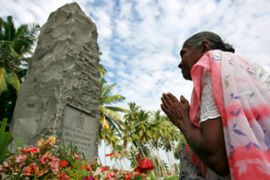Asia marks tsunami anniversary
Memorial services held for the more than 200,000 victims of 2004 natural disaster.

In Patong, a seaside district in Phuket popular with Western tourists, local artists performed traditional Thai songs in a pavilion where tourists gathered to look at photographs of the tsunami’s damage.
A candlelight vigil was planned for Saturday evening.
Emotional scars
Al Jazeera’s Aela Callan, reporting from Patong beach, said it was clear that life had moved on, even though the emotional scars would be there for years.
“Here it’s hard to find physical evidence of the tsunami, [except] for the towers which have been installed for early-detection systems and also the tsunami warning signs that line the coastline,” she said.
| TSUNAMI SPECIAL | |||||||||||||||||||
|
“But hundreds of Thai children remain in orphanages and many people are still scared of the sea, ensuring that for years to come, the big wave will continue to be remembered.”
In Indonesia’s Banda Aceh, survivors gathered in neighbourhood mosques or homes on Saturday to remember those killed.
Indonesia was the worst-hit country, with the number of dead and missing over 166,000.
Massive reconstruction aid in Banda Aceh has rebuilt a new city on top of the ruins, and many survivors are only now putting memories of the waves behind them.
Some locals say they have moved on, helped along by new homes in the Banda Aceh region following one of the largest foreign fund-raising exercises.
But still pockets of people remain homeless.
Many residents are now too frightened of the sea to rebuild close to the water.
Warning systems
Experts say thousands of lives could have been saved in 2004 if an early warning system was in place.
The Oceanographic Commission of Unesco has established six working groups after the disaster to assist Indian Ocean nations in establishment of tsunami notification systems.
The groups are dealing with issues such as seismic stations, sea-level monitoring, and risk assessment.
 |
| Foreign tourists were among the 5,398 people killed by the tsunami in Thailand [EPA] |
Cherdsak Virapat, executive director of the International Ocean Institute in Bangkok, told Al Jazeera that countries around the Indian Ocean are now far better prepared for any future tsunami, pointing to the working groups, of which five are already in place.
“The sixth group – on mitigation, preparedness and response – is a challenging one,” he said.
“It will be dealing with the knowledge capacity building for the community in the tsunami-prone area.”
In Thailand, 5,398 people were killed, including several thousand foreign tourists. The waves swamped six coastal provinces, turning some of the world’s most beautiful beaches into mass graves. Many are still missing.
Almost all of those killed were vacationing on or around Phuket, a region that had contributed as much as 40 per cent of Thailand’s annual tourism income.
In Patong, tourism is down but few blame the tsunami. Most locals blame the global recession.
Recovery efforts
Tsunami aid efforts have mostly finished, Patrick Fuller, Tsunami Communications Co-ordinator at the Red Cross, said.
“A lot of the physical reconstruction has ended,” he said. “There are some major infrastructure projects that are still going on. There are some road projects, longer term projects. But all the housing projects are pretty much wrapped up.”
The Red Cross has built 51,000 houses over the past five years, mostly in the Maldives and Indonesia.
| WEB LINK |
|
Al Jazeera is not responsible for the content of external websites |
But people Thailand say they need more than new buildings, clean-water plants and other infrastructure.
“The economy has not recovered,” said Rotjana Phraesrithong, who is in charge of the Baan Tharn Namchai Orphanage, set up in 2006 for 35 children who lost parents in the tsunami.
Dozens of small hotels and resorts are up for sale in Phang Nga, a province north of Phuket whose coastline includes Nam Khem and Khao Lak beach, two of Thailand’s worst tsunami-hit areas.
On Khao Lak beach, where the tsunami killed more than 3,000 people, there is little physical evidence of it aside from occasional “Tsunami Hazard Zone” signs and colour-coded evacuation maps.
A symbol of the catastrophe, the Sofitel Magic Lagoon where more than 300 guests and staff died, reopened last month as the 298-room JW Marriott Khao Lak Resort & Spa.
